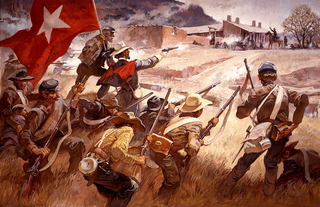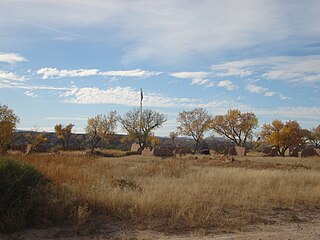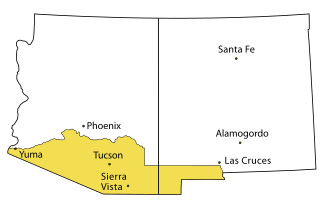Related Research Articles

The Territory of New Mexico was an organized incorporated territory of the United States from September 9,1850,until January 6,1912. It was created from the U.S. provisional government of New Mexico,as a result of Nuevo México becoming part of the American frontier after the Treaty of Guadalupe Hidalgo. It existed with varying boundaries until the territory was admitted to the Union as the U.S. state of New Mexico in 1912. This jurisdiction was an organized,incorporated territory of the US for nearly 62 years,the longest period of any territory in the contiguous United States.

The Territory of Arizona,commonly known as the Arizona Territory,was a territory of the United States that existed from February 24,1863,until February 14,1912,when the remaining extent of the territory was admitted to the Union as the state of Arizona. It was created from the western half of the New Mexico Territory during the American Civil War.

Arizona Territory,colloquially referred to as Confederate Arizona,was an organized incorporated territory of the Confederate States of America that existed from August 1,1861,to May 26,1865,when the Confederate States Army Trans-Mississippi Department,commanded by General Edmund Kirby Smith,surrendered at Shreveport,Louisiana. However,after the Battle of Glorieta Pass,the Confederates had to retreat from the territory,and by July 1862,effective Confederate control of the territory had ended. Delegates to the secession convention had voted in March 1861 to secede from the New Mexico Territory and the Union,and seek to join the Confederacy. It consisted of the portion of the New Mexico Territory south of the 34th parallel,including parts of the modern states of New Mexico and Arizona. The capital was Mesilla,along the southern border. The breakaway region overlapped Arizona Territory,established by the Union government in February 1863.

The New Mexico campaign was a military operation of the trans-Mississippi theater of the American Civil War from February to April 1862 in which Confederate Brigadier General Henry Hopkins Sibley invaded the northern New Mexico Territory in an attempt to gain control of the Southwest,including the gold fields of Colorado and the ports of California. Historians regard this campaign as the most ambitious Confederate attempt to establish control of the American West and to open an additional theater in the war. It was an important campaign in the war's Trans-Mississippi Theater,and one of the major events in the history of the New Mexico Territory in the American Civil War.

John Robert Baylor was a US Indian agent,publisher and editor,politician,and a senior officer of the Confederate States Army. After being dismissed as Indian agent,he became one of the founding editors of The White Man,a newspaper in North Texas,and a strong critic of Governor Sam Houston.

Dr. Lewis S. Owings was an American politician,physician,and businessman from Tennessee who served as the 2nd Governor of Arizona Territory (Confederate),in exile,from 1862 to 1865. He had previously served as provisional governor of Arizona Territory from 1860 to 1861.

Granville Henderson Oury was a nineteenth-century American politician,lawyer,judge,soldier,and miner.

The First Battle of Mesilla was fought on July 25,1861,at Mesilla in New Mexico Territory,in present-day Doña Ana County,New Mexico.
The trans-Mississippi theater of the American Civil War was the scene of the major military operations west of the Mississippi River. The area is often thought of as excluding the states and territories bordering the Pacific Ocean,which formed the Pacific coast theater of the American Civil War (1861–1865).

The New Mexico Territory,comprising what are today the U.S. states of New Mexico and Arizona,as well as the southern portion of Nevada,played a small but significant role in the trans-Mississippi theater of the American Civil War. Despite its remoteness from the major battlefields of the east,and its being part of the sparsely populated and largely undeveloped American frontier,both Confederate and Union governments claimed ownership over the territory,and several important battles and military operations took place in the region. Roughly 7,000-8,000 troops from the New Mexico Territory served the Union,more than any other western state or territory.

Fort Selden was a United States Army post,occupying the area in what is now Radium Springs,New Mexico. The site was long a campground along the El Camino Real de Tierra Adentro. It was the site of a Confederate Army camp in 1861. The U.S. Army established Fort Selden in 1865 for the purpose of protecting westward settlers from Native American raids,but the post fell into disrepair after the American Civil War. It was ultimately abandoned in 1891,due in large part to the decision to expand Fort Bliss and the lack of any expenditures for repair of the facility.

The First Battle of Dragoon Springs was a minor skirmish between a small troop of Confederate dragoons of Governor John R. Baylor's Arizona Rangers,and a band of Apache warriors during the American Civil War. It was fought on May 5,1862,near the present-day town of Benson,Arizona,in Confederate Arizona.

Prior to the adoption of its name for a U.S. state,Arizona was traditionally defined as the region south of the Gila River to the present-day Mexican border,and between the Colorado River and the Rio Grande. It encompasses present-day Southern Arizona and the New Mexico Bootheel plus adjacent parts of Southwestern New Mexico. This area was transferred from Mexico to the United States in the Gadsden Purchase of 1853. Mining and ranching were the primary occupations of traditional Arizona's inhabitants,though growing citrus fruits had long been occurring in Tucson.
The San Elizario Spy Company or Coopwood Spy Company was an independent volunteer company of cavalry formed by Captain Bethel Coopwood and mustered into Confederate service on July 11,1861 in El Paso,Texas.
The Company A,Arizona Rangers was a cavalry formation of the Confederate States Army during the American Civil War.
The Department of New Mexico was a department of the United States Army during the mid-19th century. It was created as the 9th Department,a geographical department,in 1848 following the successful conclusion of the Mexican–American War,and renamed Department of New Mexico in 1853. It had to contend with an invading Confederate force during the New Mexico Campaign of the American Civil War from mid-1861 to early 1862,then with Apache tribes during the remainder of the conflict. It was merged into the Department of California after the end of the war as the District of New Mexico.
The history of Tucson,Arizona began thousands of years ago. Paleo-Indians practiced plant husbandry and hunted game in the Santa Cruz River Valley from 10,000 or earlier BCE. Archaic peoples began making irrigation canals,some of the first in North America,around 1,200 BCE. The Hohokam people lived in the Tucson area from around 450–1450 CE in a complex agricultural society.

Union forces entered Tucson on May 20,1862,with a force of 2,000 men without firing a shot.
Thomas J. Mastin was a Confederate captain,attorney,and businessman. He founded the Arizona Guards,who fought as a part of the Confederate Army in the American Civil War and the Apache Wars.
References
- Beers,Henry Putney,The Confederacy:A Guide to the Archives of the Government of the Confederate States of America. Washington,D.C.:United States National Archives and Records Administration,1986.
- Current,Richard N.,Encyclopedia of the Confederacy. New York:Simon &Schuster,1993. ISBN 0-13-275991-8.
- Journal of the Congress of the Confederate States of America, 1861–1865. Washington, D.C.: United States War Department, Government Printing Office, 1905.
- History of New Mexico. Volume II, Los Angeles, Chicago, New York: Pacific States Publishing Co., 1907.